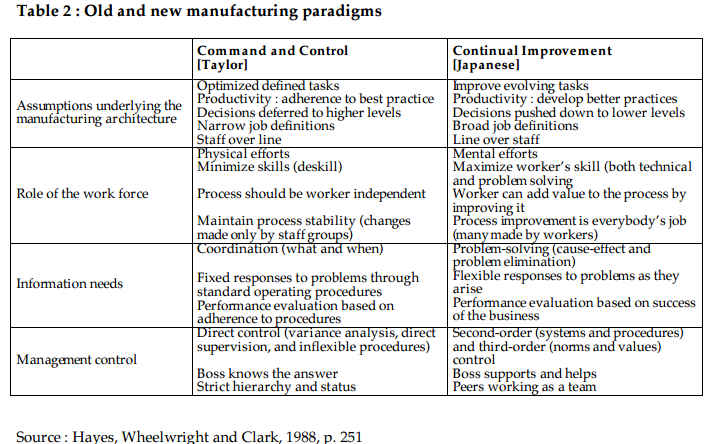From Manufacturing to Design
Summary
According to seminal product development literature, integrated development of complex products requires a strong unifying force, as embodied in the Heavyweight Product Manager.
Book - From Manufacturing to Design
Seminal paper on New Product Development - File:NPD.pdf
(page 9 of From Manufacturing to Design). Note the implacatio n in the table a ove appears to be that 'command and control' is the opposite of 'continual improvement'.
Main Points
- P. 9 - Role of management is to foster learning capacity, not oversee production.
- P. 13 - Focus in improved new product development: (1) heavyweight product managers for assuring an integrated product - who had influence both on developers and senior managers; (2) overlapping problem-solving cycles (also called concurrent engineering); and (3) the integration of customers and suppliers into product development activities.
- P. 31 - Steven Eppinger developed tools and methods for observing and representing design dependencies (in modular design) using the framework of Design Structure Matrices (DSMs)
- P. 37 - “The Architecture of Participation” was Baldwin and Clark’s attempt to answer these questions (Baldwin and Clark, 2006a). It was also their first foray into the second phase of their research plan, which aimed to look the economic institutions needed to support design evolution. Taking their lead from Masahiko Aoki (2001), an eminent theorist in the field of new institutional economics, Baldwin and Clark sought to model open source development as a game among user-innovators, a game that would be played “on top of” designs with different architectures. Their analysis showed that there was a high degree of complementarity between users’ participation in a collective development process and the architecture of the underlying system. Specifically, systems with more modular architectures, more divisible task structures, and/or more option value in the modules would attract more voluntary effort. Thus, Baldwin and Clark concluded, a user-driven innovation process based on the free revealing and sharing of designs was a viable institutional form. Open source development was a sustainable “institution of innovation,” — one that was competitive with, and in some cases might dominate, proprietary product developmentdevelopment
Summary
The paper appears to imply that modularity and open source are key to accelerated learning and product development - and these features are competitive with or superior to proprietary development. This is groundbreaking work - as it goes against the entire current paradigm of corporate command and control - at least in companies like Google and Apple, which rely on complete monopolization of IP.
Thoughts?


